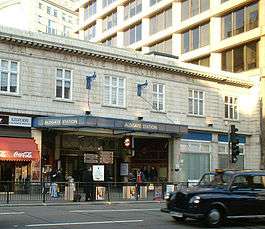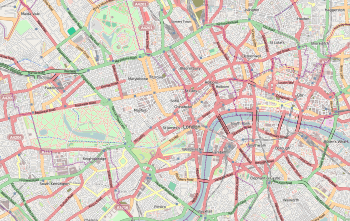Aldgate tube station
Aldgate is a London Underground station near Aldgate in the City of London. The station is on the Circle line between Tower Hill and Liverpool Street, and is the eastern terminus of the Metropolitan line. It is in Travelcard Zone 1.[4]
| Aldgate | |
|---|---|
 Station entrance | |
 Aldgate Location of Aldgate in Central London | |
| Location | Portsoken |
| Local authority | City of London |
| Managed by | London Underground |
| Number of platforms | 4 |
| Fare zone | 1 |
| OSI | Aldgate East |
| London Underground annual entry and exit | |
| 2014 | |
| 2015 | |
| 2016 | |
| 2017 | |
| 2018 | |
| Key dates | |
| 18 November 1876 | Opened |
| Other information | |
| External links | |
| WGS84 | 51.514°N 0.076°W |
Aldgate was opened in 1876 with its entrance on Aldgate High Street. A station named Aldgate East opened nearby eight years later[5] and is served today by the District and Hammersmith & City lines.[4]
History
The route first proposed ran south from Moorgate to Cannon Street, but this was soon amended to the present alignment to allow connection with three additional termini: Liverpool Street, Broad Street, and Fenchurch Street.[6] However, this change also forced an awkward doubling-back at Aldgate, reducing the desirability of the line for local traffic and greatly increasing the cost of construction due to high prices in the City of London.[6] Construction was also complicated because the station was on the site of a plague pit which contains an estimated 1,000 bodies.
Aldgate station was opened on 18 November 1876, with a southbound extension to Tower Hill opening on 25 September 1882, completing the Circle (line).[6] Services from Aldgate originally ran further west than they do now, reaching as far as Richmond.
The train shed of 1876 survives, hidden from the street by the later station frontage building erected in 1926. This was designed by Charles Walter Clark the Metropolitan Railway's chief architect between 1911 and 1933.[n 1]
The station building has a six-bay façade clad in white faïence with original features including 1920s shopfronts with green marble and pink granite stallrisers, a half-hexagonal canopy of glass and metal suspended by elegant metal ties, leaded light first floor windows, dentil cornice, two ornamental lamp brackets and a frieze bearing moulded lettering and the Metropolitan Railway monogram.
Aldgate became the terminus of the Metropolitan line in 1941. Before that, Metropolitan trains had continued on to the southern termini of the East London Line.
In 2005, one of four suicide bombers involved in the 7 July terrorist attacks detonated a device on a C-stock Circle line train from Liverpool Street and was approaching Aldgate.[7] Seven passengers were killed in the bombing.[7] Of the stations affected by the bombings, Aldgate was the first to be reopened, once police had handed back control of the site to London Underground following an extensive search for evidence. Once the damaged tunnel was repaired by Metronet engineers, the lines were reopened. This also allowed the Metropolitan line to be fully restored, since the closure had meant all trains had to be terminated two stations early, at Moorgate.[8]
Services
On the Circle line the typical off-peak service measured in trains per hour (tph) is:
- 6 tph clockwise to Edgware Road via Embankment;[6][9]
- 6 tph anti-clockwise to Hammersmith via King's Cross St. Pancras.[6][10]
On the Metropolitan line the typical off-peak service in trains per hour is:
- 2 tph northbound to Amersham;[8][11]
- 2 tph northbound to Chesham;[8][11]
- 8 tph northbound to Uxbridge.[8][11]
- 12 tph terminating at Aldgate
During peak hours there are also additional fast and semi-fast Metropolitan line services, with some following the route to and from Watford.[8]
Connections
London Buses routes 15, 25, 42, 78, 100, 115, 135, 205, 242, 254 and 343, and night routes N15, N25, N205, N253, N550 and N551 serve the station.[12]
Cultural references
Aldgate station plays a role in the Sherlock Holmes story The Adventure of the Bruce-Partington Plans (published in the anthology His Last Bow).
In the story, the body of a junior clerk named Cadogan West is found on the tracks outside Aldgate, with a number of stolen plans for the Bruce-Partington submarine in his pocket. It seems clear enough that "the man, dead or alive, either fell or was precipitated from a train." But why, wonders Holmes, did the dead man not have a ticket? It turns out that the body was placed on top of a train carriage before it reached Aldgate, via a window in a house on a cutting overlooking the Metropolitan line. Holmes realises that the body fell off the carriage roof only when the train was jolted by the dense concentration of points at Aldgate.
Aldgate is also mentioned in John Creasey's 1955 detective novel Gideon's Day. It has also appeared in two films: Four in the Morning (1965) starring Ann Lynn and Norman Rodway and V for Vendetta (2006), starring Hugo Weaving and Natalie Portman.
Notes and References
Notes
- Clark designed other station buildings for the Metropolitan Railway in this period to a similar design faced in the same white faïence such as Farringdon (1922 - Grade II listed), Edgware Road (1928) and Willesden Green (1925 - Grade II listed), the Grade II* listed Baker Street station and the Chiltern Court apartment building that rises above it (completed in 1929). He also designed outer suburban stations on the line to Stanmore (1932).
References
- "Out-of-Station Interchanges" (Microsoft Excel). Transport for London. 2 January 2016. Retrieved 28 August 2016.
- "Multi-year station entry-and-exit figures (2007-2017)" (XLSX). London Underground station passenger usage data. Transport for London. January 2018. Retrieved 22 July 2018.
- "Station Usage Data" (CSV). Usage Statistics for London Stations, 2018. Transport for London. 21 August 2019. Retrieved 27 April 2020.
- Standard Tube Map (PDF) (Map). Not to scale. Transport for London. May 2020. Archived (PDF) from the original on 7 July 2020.
- Clive's Underground Line Guides - District line
- Clive's Underground Line Guides - Circle line
- Laville, Sandra; Aslam, Dilpazier (14 July 2005). "Trophy-rich athlete who turned to jihad". The Guardian. London. Archived from the original on 23 May 2010.
- Clive's Underground Line Guides - Metropolitan line
- "Circle line timetable: From Aldgate Underground Station to Tower Hill Underground Station". Transport for London. Retrieved 28 March 2015.
- "Circle line timetable: From Aldgate Underground Station to Liverpool Street Underground Station". Transport for London. Retrieved 28 March 2015.
- "Metropolitan line timetable: From Aldgate Underground Station to Liverpool Street Underground Station". Transport for London. Retrieved 28 March 2015.
- "Buses from Aldgate and Fenchurch Street" (PDF). Transport for London. September 2014. Retrieved 28 March 2015.
External links
| Wikimedia Commons has media related to Aldgate tube station. |
| Preceding station | Following station | |||
|---|---|---|---|---|
| Circle line | ||||
| Metropolitan line | Terminus | |||
| Former services | ||||
| Preceding station | Following station | |||
towards Hammersmith | Circle line (1884–1967) | towards Edgware Road |
||